Do-it-yourself burning preparation: is it possible to freeze horseradish for the winter and how to do it correctly
Horseradish is one of the best natural antiseptics. It is used to prepare sauces, seasonings, snacks, pickled and salted vegetables, and cold soups. The product improves appetite, increases the body's defenses during epidemics of influenza and acute respiratory viral infections, is used in the treatment of sore throat, and alleviates gout, rheumatism, and kidney stones.
Freezing ensures the preservation of the beneficial properties of horseradish, improves the taste and eliminates the pungent odor of the root. In this article we will tell you how to freeze roots and leaves, how to properly store and use the preparations.
Is it possible to freeze horseradish for the winter?
Horseradish is the only plant that can withstand temperatures down to -90°C without losing its beneficial properties, so freezing it for the winter is not only possible, but also necessary. The advantage of this storage method is the loss of the pungent odor, which forces housewives to suffer in the process of grinding the roots on a grater. The second advantage of freezing a product is an increase in taste.
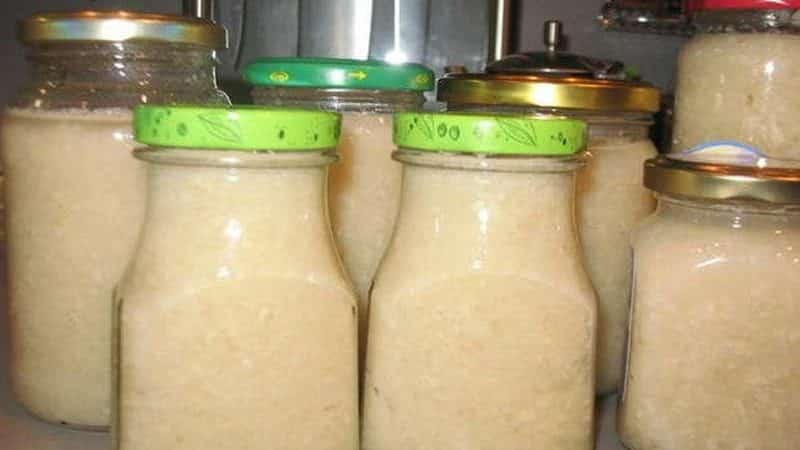 Horseradish is characterized by high nutritional value - the leaves and roots contain B vitamins, vitamin C, E, K and PP, potassium, calcium, sodium, magnesium, sulfur, phosphorus, iron, copper, fluorine, zinc.
Horseradish is characterized by high nutritional value - the leaves and roots contain B vitamins, vitamin C, E, K and PP, potassium, calcium, sodium, magnesium, sulfur, phosphorus, iron, copper, fluorine, zinc.
Reference. 100 g of product contains 61.1% of the daily requirement of ascorbic acid.
Selection and preparation of horseradish for freezing
Juicy roots without dark spots, damage and signs of rotting at the age of 2-3 years are suitable for freezing.The leaves should be fresh, green and crisp. When cut, the roots should be milky or white.
The roots are soaked in cold water for 1-2 hours to remove dirt and make cleaning easier. The washed roots are brushed and the skin is cut off with a sharp knife or vegetable peeler. To minimize exposure to air, place the peeled horseradish in a bowl of ice water. This will preserve the aromatic substances of the plant. Then the roots are dried with a paper or waffle towel and frozen.
Horseradish leaves are thoroughly washed under the tap, placed between two towels or dried in a salad and herb dehydrator to remove water.
The photo shows horseradish roots and leaves.
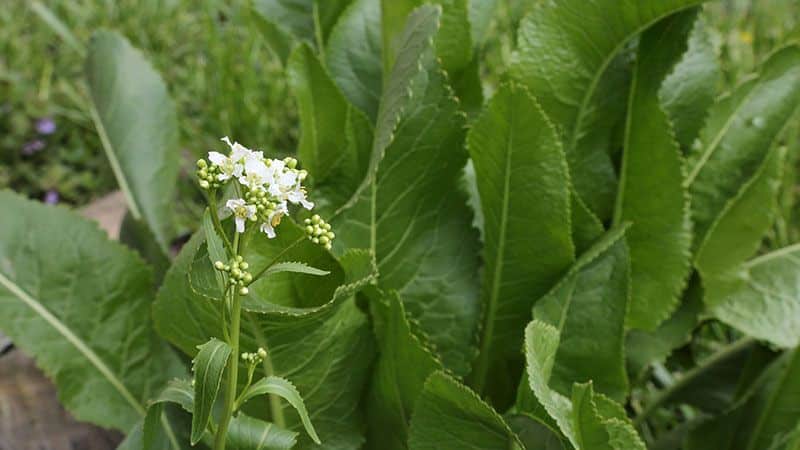
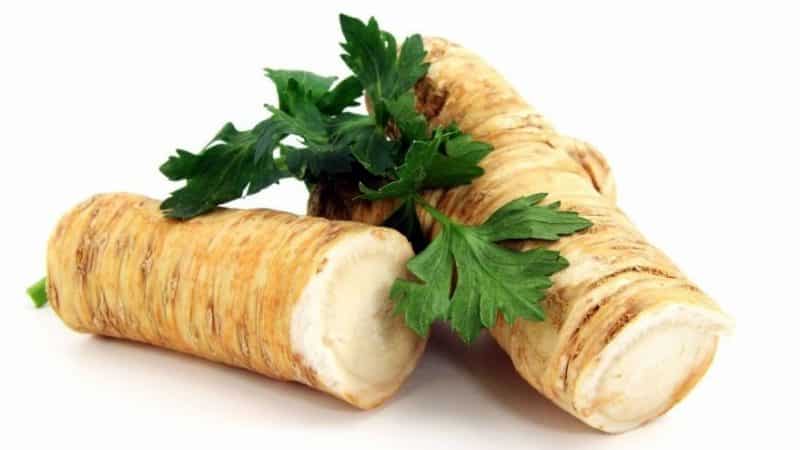
Freezing methods
There are several methods of freezing, depending on the purpose of use in cooking. The roots are frozen whole, in pieces, or grated.
Entirely
Roots without peel are placed in plastic bags of 3-4 pieces. or wrapped in cling film. Then place it in the freezer compartment of the refrigerator.
Pieces
The peeled roots are cut into 2-3 cm pieces and placed in freezer bags or food containers. Thick bags with a zip lock are ideal - they do not allow air or foreign odors to pass through.
Containers are sealed with lids or wrapped in cling film. The preparations are placed in the freezer. After 3-4 hours, take out the workpiece and shake it - this way the pieces will not stick together into one mass.
This is interesting:
Features of pickling cucumbers for the winter in a barrel.
Recipes for canned watermelons for the winter without sterilization.
Grated
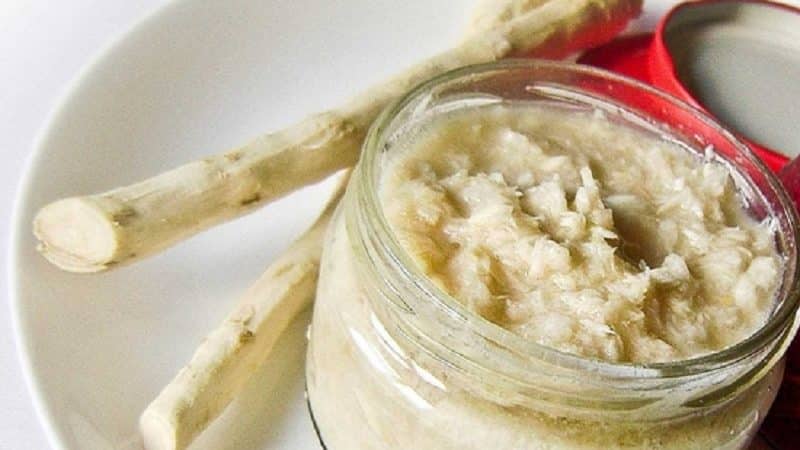
The method of storing grated horseradish is labor-intensive, but you will already have a ready-made component for preparing dishes. Peeled and soaked horseradish in cold water, grate it manually on a fine grater or use a more gentle method of grinding it in a blender or meat grinder.
To protect the eyes and respiratory organs, wear a respirator, if available, or a cotton-gauze bandage, and construction glasses.
A plastic bag is pulled over the outlet of the meat grinder so that the chopped horseradish falls directly into it. Thus, it is possible to minimize the release of odorous vapors into the air.
Prepared horseradish is packaged in freezer bags or trays.
Advice. Mix chopped horseradish with grated apple and lemon juice. Use it as a snack or dressing.
Leaves
Prepared horseradish leaves are placed in bags whole or cut into strips. This preparation enriches the taste of meat dishes, soups, appetizers, and sandwiches.
Shelf life
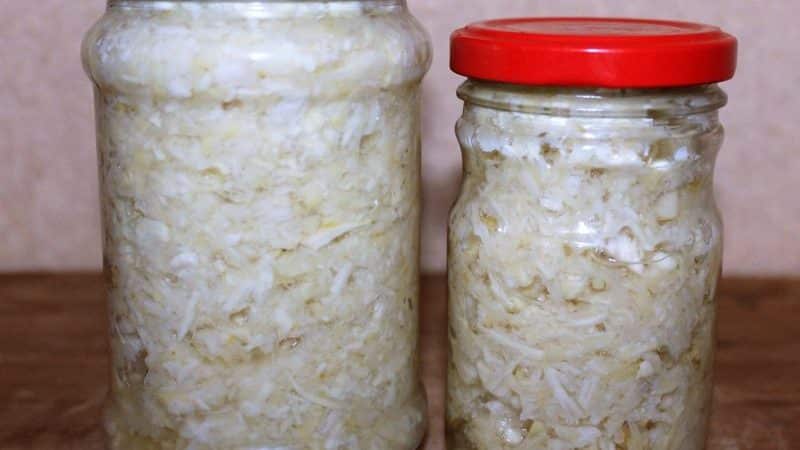
Roots and leaves are stored in the freezer:
- 10-12 months at a temperature of -18°C;
- 6 months at a temperature of -5°C;
- 3-4 months at 0…-2°C.
Proper defrosting
Frozen roots and leaves do not require preliminary defrosting. If necessary, whole or cut into pieces roots are placed in a blender with a power of 700 W or more or a meat grinder and chopped. If the blender does not “take” dry roots, you can add a couple of spoons of ketchup.
Grated horseradish and leaves are already ready for use; they are immediately added to dishes.
Application
Horseradish is widely used in cooking for the preparation of:
- cold soups: botvinya, okroshka, mushroom, vegetable, borscht;
- gravy for meat and fish;
- sauces with sour cream, yogurt, mayonnaise with the addition of lingonberries, cranberries, dill, parsley;
- homemade alcoholic drinks (hrenovukha);
- savory appetizers for meat with tomatoes or beets;
- marinades, pickles;
- spicy salads.
A culinary masterpiece called “khrenovina”, “khrenoder” has long been loved by fans of savory snacks. Other names for this seasoning are “Ogonyok”, “Russian adjika”. The appetizer is prepared from tomatoes, garlic and horseradish root twisted in a meat grinder. The finished mixture is salted to taste, seasoned with vinegar, black or red ground pepper. The proportions are arbitrary, depending on the desired spiciness.
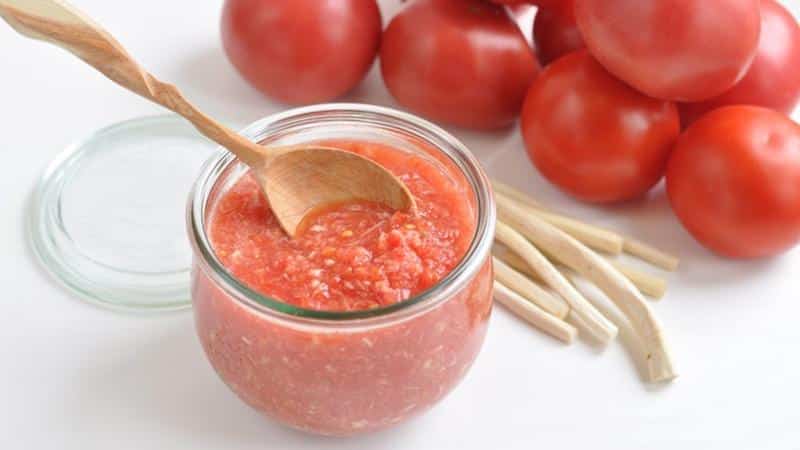
A spicy sauce is prepared with horseradish leaves.
For this recipe take:
- 300 g fresh or frozen horseradish leaves;
- 1 kg of tomatoes;
- 6-8 cloves of garlic;
- sugar and salt - to taste.
All components of the sauce are ground in a meat grinder and sugar and salt are added. The resulting mass is placed in clean 250 ml jars and placed in the refrigerator for storage for three months.
Read also:
How to prepare cabbage with horseradish: recipes from experienced housewives.
The best recipes for pickled cabbage with horseradish from experienced housewives.
How to cook sauerkraut with horseradish and carrots is tasty and simple.
Conclusion
Freezing horseradish has the main advantage - the roots become less spicy, but at the same time retain their taste and vitamin composition. The roots, pre-cleaned and soaked in cold water, are frozen whole, in pieces or crushed on a grater, meat grinder or blender. The leaves are simply washed, dried and placed in food bags.
The preparations are stored for up to a year at a temperature of -18°C. No pre-defrosting is required. The product is immediately used for its intended purpose - added to soups, sauces, snacks.